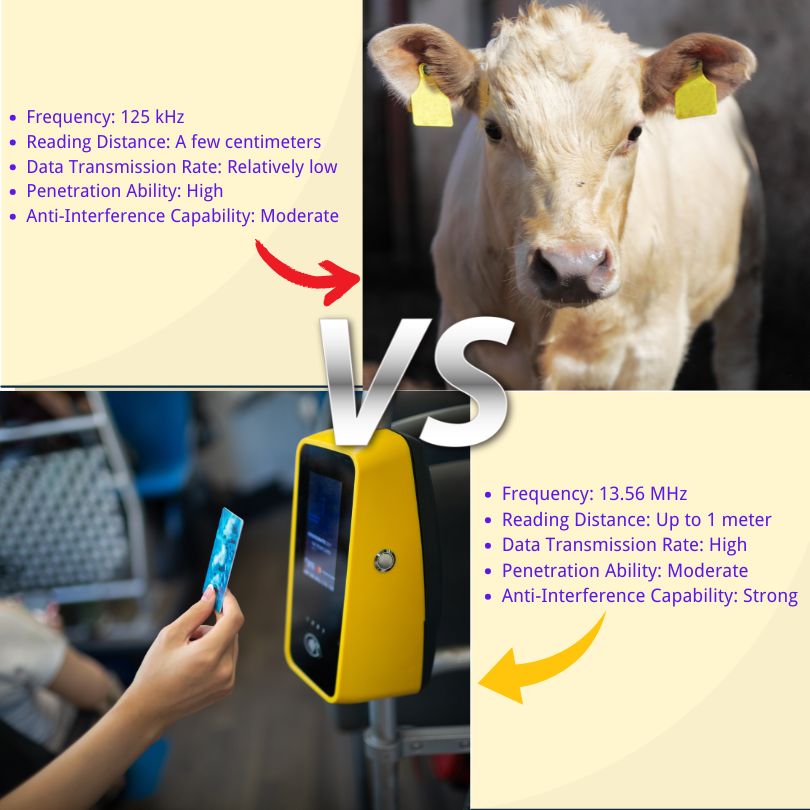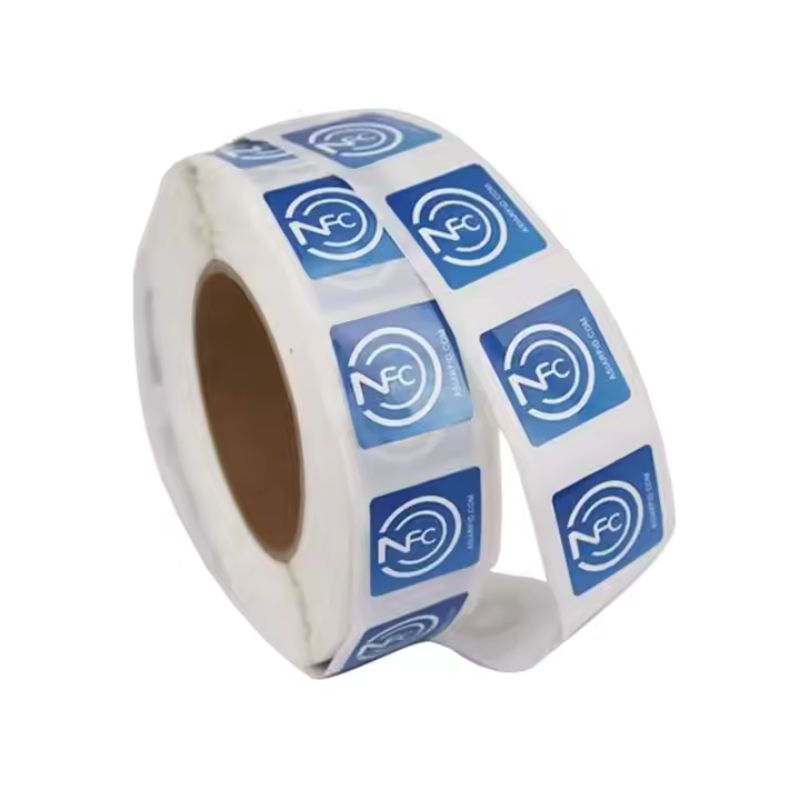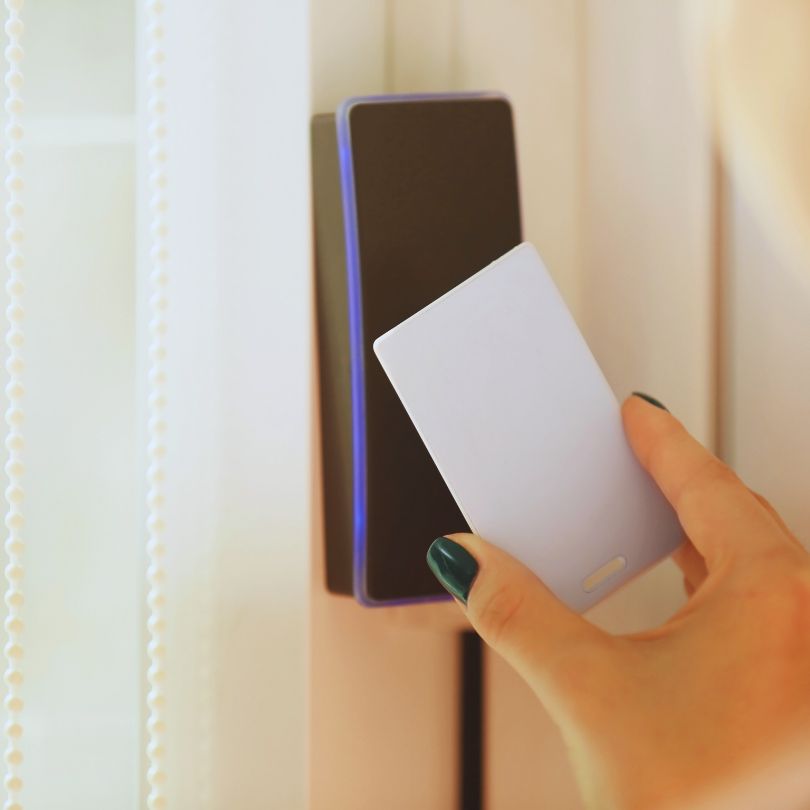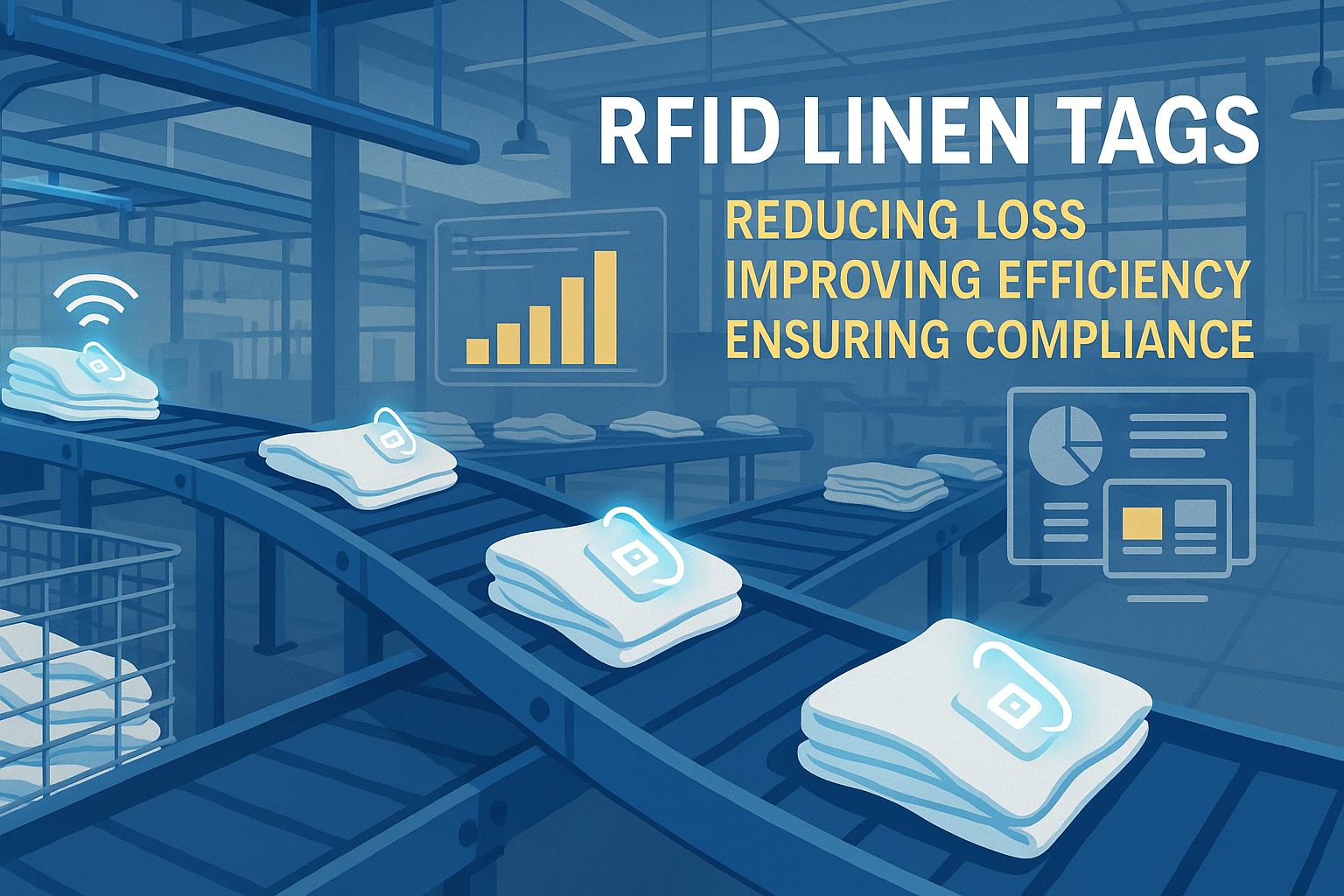
Zrozumienie różnic między tagami RFID 13,56 MHz i 125 kHz
Spis treści
Zrozumienie różnic między tagami RFID 13,56 MHz i 125 kHz

Co naprawdę oznacza częstotliwość RFID (LF vs HF)
Systemy RFID wykorzystują fale radiowe do komunikacji między tagi i czytniki. Częstotliwość, z jaką są używane, wpływa na to, jak daleko mogą odczytywać dane, jak szybko je przesyłają, jak zachowują się w pobliżu metalu lub wody oraz jakie dane mogą przechowywać.
Oto główna idea:
Tagi RFID o niskiej częstotliwości (LF) = 125 kHz
- Krótki zasięg
- Wolniejsza prędkość transmisji danych
- Doskonała wydajność w pobliżu metali lub cieczy
- Prosty, wytrzymały i niedrogi
Wysoka częstotliwość (HF) = Znaczniki RFID 13,56 MHz - Większy zasięg
- Szybsza prędkość transmisji danych
- Bardziej zaawansowane zabezpieczenia
- Kompatybilny z NFC i smartfonami
13,56 MHz kontra 125 kHz
| Funkcja | Znaczniki RFID 13,56 MHz | Znaczniki RFID 125 kHz |
|---|---|---|
| Częstotliwość | 13,56 MHz (częstotliwość fal krótkich) | 125 kHz (LF) |
| Odczyt zakresu | Do 1 metra | 2-10 cm |
| Szybkość przesyłu danych | Wysoki | Niski |
| Wydajność w pobliżu metalu | Umiarkowany | Mocny |
| Bezpieczeństwo | Obsługuje szyfrowanie, wzajemne uwierzytelnianie | Podstawowe, zazwyczaj bez szyfrowania |
| Obsługa NFC / smartfonów | Tak | NIE |
| Koszt | Wyższy | Niżej |

Bezpieczeństwo: czy jedna częstotliwość jest bezpieczniejsza?
Znaczniki RFID 125 kHz są często stosowane w starszych systemach i zazwyczaj wykorzystują stałe, unikalne identyfikatory bez szyfrowania. Dzięki temu można je łatwo sklonować za pomocą dostępnych na rynku urządzeń. Są one odpowiednie dla systemów o niskim ryzyku, ale nie spełniają współczesnych standardów bezpieczeństwa.
Tagi RFID 13,56 MHz, zwłaszcza karty MIFARE lub DESFire, obsługują:
- Szyfrowanie
- Wzajemna autoryzacja
- Bezpieczne przechowywanie pamięci
- Wiele aplikacji na jednej karcie
Podsumowując: - W przypadku niskich wymagań bezpieczeństwa (np. klucze do szafek, zegary rejestrujące czas pracy) należy stosować tagi RFID o częstotliwości 125 kHz.
- Wybierz częstotliwość 13,56 MHz do kontroli dostępu, płatności lub dowolnego systemu przechowującego dane osobowe.
Kompatybilność z NFC i smartfonami
Jeśli Twój projekt dotyczy telefonów, tagi RFID 125 kHz nie będą działać.
Tylko Znaczniki RFID 13,56 MHz obsługa NFC (Near Field Communication) — technologii wykorzystywanej w płatnościach mobilnych, zameldowaniach i funkcjach „tap-to-pair”.
Większość smartfonów może odczytywać i zapisywać tagi NFC przy użyciu częstotliwości 13,56 MHz, co sprawia, że częstotliwość ta jest idealna do:
- Bilety cyfrowe
- Rejestracja wydarzeń
- Inteligentne plakaty
- Karty lojalnościowe
- Bezkontaktowy identyfikator mobilny
Jeśli zależy Ci na obsłudze smartfonów, jedynym wyborem jest częstotliwość 13,56 MHz.
Przykłady rzeczywistych zastosowań w różnych branżach
| Branża / Zastosowanie | Znaczniki RFID 125 kHz | Znaczniki RFID 13,56 MHz |
|---|---|---|
| Kontrola dostępu | Podstawowe systemy wejściowe, drzwi starszego typu | Bezpieczne dane uwierzytelniające, nowoczesne identyfikatory |
| Transport publiczny / Bilety | Nieobsługiwane | Karty oparte na technologii MIFARE/NFC |
| Śledzenie zwierząt | Szeroko stosowany ze względu na penetrację tkanek | Rzadki |
| Automatyka przemysłowa | Niezawodny w pobliżu metalu/cieczy, wytrzymały w użyciu | Rzadziej spotykane w trudnych warunkach środowiskowych |
| Opieka zdrowotna | Nie nadaje się do śledzenia pacjentów lub leków | Lepsze zabezpieczenie identyfikatorów i oznaczeń aktywów |
| Biblioteki / Archiwa | Rzadki | Popularny do śledzenia książek i wypożyczeń |
| Marketing / Wydarzenia | Nie dotyczy | Inteligentne plakaty, karty wstępu NFC na wydarzenia |
| Zabezpieczenie pojazdu przed kradzieżą | Wbudowane tagi RFID 125 kHz w kluczykach/zapłonach | Nie używane |

Jak wybrać między częstotliwością 13,56 MHz a 125 kHz dla swojego projektu
Skorzystaj z poniższej listy kontrolnej, aby zawęzić zakres decyzji:
1. Poziom bezpieczeństwa
- Potrzebujesz szyfrowania lub bezpiecznego dostępu? → Wybierz częstotliwość 13,56 MHz.
- Śledzenie niskiego ryzyka lub podstawowa identyfikacja? → Częstotliwość 125 kHz może być wystarczająca.
2. Środowisko
- Wysokie zakłócenia, metal lub ciecz w pobliżu? → 125 kHz działa lepiej
- Czyste biuro czy pomieszczenie wewnętrzne? → Oba rozwiązania są dobre; wybierz w zależności od funkcji.
3. Integracja ze smartfonem
- Chcesz, aby użytkownicy skanowali za pomocą telefonów? → Tylko częstotliwość 13,56 MHz obsługuje tę funkcję.
4. Budżet
- Tagi 125 kHz są tańsze w zakupie
- Jednak częstotliwość 13,56 MHz zapewnia większą wartość w dłuższej perspektywie, jeśli potrzebujesz dodatkowych funkcji lub zabezpieczeń.
Nadal korzystasz z tagów RFID 125 kHz? Modernizacja czy pozostanie przy dotychczasowym rozwiązaniu?
Tagi RFID 125 kHz są nadal szeroko stosowane w:
- Starsze systemy kontroli dostępu
- Operacje na hali produkcyjnej
- Znakowanie zwierząt gospodarskich
- Automatyczne systemy antykradzieżowe
Ale jeśli zarządzasz: - Kwalifikacje personelu
- Systemy płatności
- Wielofunkcyjne karty identyfikacyjne
- Integracja NFC
…to może nadszedł czas na zmianę.
Ścieżki aktualizacji:
- Zainstaluj czytniki dwuczęstotliwościowe
- Wydawaj karty kombinowane (obsługujące zarówno częstotliwość 13,56 MHz, jak i 125 kHz)
- Stopniowe wdrażanie: obsługa obu systemów podczas migracji
Często zadawane pytania dotyczące RFID 13,56 MHz i 125 kHz
Czy 13,56 MHz to to samo co NFC?
Tak, NFC jest rodzajem RFID o częstotliwości 13,56 MHz. Obsługuje go większość smartfonów.
Czy jeden czytnik może odczytywać obie częstotliwości?
Zazwyczaj nie. Aby obsługiwać oba typy kart, potrzebny jest czytnik obsługujący dwie technologie.
Który tag ma większy zasięg?
Częstotliwość 13,56 MHz ma zazwyczaj większy zasięg odczytu (do 1 metra). Częstotliwość 125 kHz jest ograniczona do kilku centymetrów.
Którego z nich powinienem używać do kontroli dostępu?
W przypadku nowoczesnych, bezpiecznych systemów dostępu zdecydowanie zaleca się stosowanie częstotliwości 13,56 MHz.
Dlaczego znaczniki RFID o częstotliwości 13,56 MHz i 125 kHz mają różną odległość odczytu?
Różnica w odległościach odczytu wynika przede wszystkim z częstotliwości roboczej. Wyższe częstotliwości, takie jak 13,56 MHz, mają większy zasięg, podczas gdy niższe częstotliwości, takie jak 125 kHz, są zoptymalizowane pod kątem krótszych odległości.
Który znacznik RFID jest bardziej odpowiedni do stosowania w środowiskach metalowych czy ciekłych?
Tagi RFID 125 kHz są skuteczniejsze w środowiskach, w których znajdują się metale lub ciecze ze względu na ich lepsze właściwości penetracyjne.
Czy koszt tagów RFID ma wpływ na wybór?
Tak, tagi RFID 125 kHz są generalnie bardziej opłacalne, co czyni je odpowiednią opcją dla aplikacji o ograniczonym budżecie. Jednak wybór powinien również uwzględniać wymagania dotyczące wydajności i środowiska aplikacji.
Najważniejsze standardy i typy chipów
13,56 MHz (częstotliwość fal krótkich)
- ISO/IEC 14443: Stosowany w kartach zbliżeniowych (MIFARE, DESFire)
- ISO/IEC 15693: większy zasięg, stosowany w bibliotekach, logistyce
- ISO 18000-3: Śledzenie na poziomie pojedynczych produktów
125 kHz (LF)
- Formaty zastrzeżone, często o stałym identyfikatorze (np. EM4100, HID Prox)
- Najczęściej używane w starszych systemach i podstawowych aplikacjach
Ostateczne wnioski
Jeśli nadal zastanawiasz się, którą drogę wybrać, oto podsumowanie:
Używaj tagów RFID 125 kHz do:
- Trudne warunki (metal/ciecz)
- Aplikacje o niskim poziomie bezpieczeństwa
- Wdrożenia z uwzględnieniem budżetu
- Systemy starszego typu
Używaj tagów RFID 13,56 MHz do:
- Obsługa urządzeń mobilnych/NFC
- Bezpieczny dostęp i płatności
- Karty wielofunkcyjne
- Systemy gotowe na przyszłość
Oba mają swoje zastosowanie — ale wybór należy dokonać w oparciu o konkretny przypadek użycia, a nie tylko koszt lub przyzwyczajenie.
Uwagi
Gorące produkty

Czym jest zarządzanie odpadami za pomocą technologii RFID
Wyobraź sobie miasto, w którym każdy kosz na śmieci „mówi” – nie dosłownie, ale za pomocą niewielkiego chipa, który informuje system, kiedy jest pełny, kiedy został opróżniony i gdzie trafiły śmieci. Tak właśnie działa obecnie system zarządzania odpadami oparty na technologii RFID.

Czym są uszczelnienia śrub i jakie są ich zastosowania? | Kompletny przewodnik
W globalnym handlu i logistyce plomby odgrywają kluczową rolę w zapewnianiu bezpieczeństwa i zgodności ładunków. Te małe, ale potężne urządzenia są przeznaczone do blokowania kontenerów transportowych, przyczep i drzwi ładunkowych za pomocą mechanizmu zabezpieczającego przed manipulacją.

Czym jest ochraniacz karty RFID? Korzyści, przypadki użycia i przewodnik zakupu
Technologia RFID (Radio Frequency Identification) jest wszędzie: w kartach kredytowych, identyfikatorach, przepustkach, kluczach do pokoi hotelowych i nie tylko. Oferuje szybkość i wygodę, ale otwiera również drzwi do nowego rodzaju kradzieży cyfrowej zwanej "skimmingiem". W tym miejscu pojawia się ochrona kart RFID.

Opaski RFID na rękę na imprezy: Przewodnik zakupów hurtowych dla organizatorów
Opaski RFID na nadgarstki na imprezy stają się rozwiązaniem dla organizatorów, którzy potrzebują szybszego wejścia, zapobiegania oszustwom i płatności bezgotówkowych na koncertach, festiwalach i obiektach sportowych. W przeciwieństwie do biletów papierowych lub kodów QR, te inteligentne opaski na rękę wykorzystują wbudowane chipy, aby usprawnić dostęp, zabezpieczyć transakcje i poprawić wrażenia gości.

Jak znacznik RFID na przedniej szybie usprawnia kontrolę dostępu do pojazdu i systemy poboru opłat drogowych
W dzisiejszym szybko zmieniającym się świecie identyfikacja pojazdów musi być szybka, bezpieczna i bezdotykowa. Znacznik RFID na przedniej szybie zapewnia właśnie to - niezawodny sposób zarządzania poborem opłat, parkowaniem i dostępem do bramek bez zatrzymywania pojazdów.

Korzyści z tagów RFID do bielizny w pralniach komercyjnych
Zarządzanie pralnią w szpitalach, hotelach lub dużych pralniach to duże zadanie. Każdego dnia tysiące prześcieradeł, ręczników i uniformów jest pranych, sortowanych i wysyłanych z powrotem. Jednak problemy takie jak zagubiona pościel, błędy w sortowaniu i ręczne liczenie mogą kosztować firmy dużo pieniędzy. Na przykład, średniej wielkości hotele mogą tracić ponad $200,000 każdego roku z powodu zaginionej pościeli.
W tym miejscu z pomocą przychodzą znaczniki RFID Linen Tag.
Tagi
POWIĄZANE BLOGI

Czym jest zarządzanie odpadami za pomocą technologii RFID
Wyobraź sobie miasto, w którym każdy kosz na śmieci „mówi” – nie dosłownie, ale za pomocą niewielkiego chipa, który informuje system, kiedy jest pełny, kiedy został opróżniony i gdzie trafiły śmieci. Tak właśnie działa obecnie system zarządzania odpadami oparty na technologii RFID.

Czym są uszczelnienia śrub i jakie są ich zastosowania? | Kompletny przewodnik
W globalnym handlu i logistyce plomby odgrywają kluczową rolę w zapewnianiu bezpieczeństwa i zgodności ładunków. Te małe, ale potężne urządzenia są przeznaczone do blokowania kontenerów transportowych, przyczep i drzwi ładunkowych za pomocą mechanizmu zabezpieczającego przed manipulacją.

Czym jest ochraniacz karty RFID? Korzyści, przypadki użycia i przewodnik zakupu
Technologia RFID (Radio Frequency Identification) jest wszędzie: w kartach kredytowych, identyfikatorach, przepustkach, kluczach do pokoi hotelowych i nie tylko. Oferuje szybkość i wygodę, ale otwiera również drzwi do nowego rodzaju kradzieży cyfrowej zwanej "skimmingiem". W tym miejscu pojawia się ochrona kart RFID.




